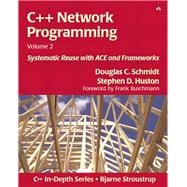
Note: Supplemental materials are not guaranteed with Rental or Used book purchases.
Purchase Benefits
What is included with this book?
Dr. Douglas C. Schmidt is the original developer of ACE and The ACE ORB (TAO). He is a Professor at Vanderbilt University, where he studies patterns, optimizations, middleware, and model-based tools for distributed real-time and embedded systems. He is a former editor-in-chief of C++ Report and columnist for C/C++ Users Journal.
Stephen D. Huston is President and CEO of Riverace Corporation, a provider of technical support and consulting services to companies who want to keep software projects on track using ACE. Steve has nearly ten years of experience with ACE, and more than twenty years of software development experience, focusing on network protocol and C++ networked application development in a wide range of hardware and software environments.
| Foreword | vii | ||||
| About This Book | xi | ||||
|
1 | (22) | |||
|
1 | (3) | |||
|
4 | (8) | |||
|
12 | (2) | |||
|
14 | (5) | |||
|
19 | (2) | |||
|
21 | (2) | |||
|
23 | (16) | |||
|
24 | (10) | |||
|
34 | (4) | |||
|
38 | (1) | |||
|
39 | (48) | |||
|
39 | (3) | |||
|
42 | (4) | |||
|
46 | (15) | |||
|
61 | (9) | |||
|
70 | (16) | |||
|
86 | (1) | |||
|
87 | (28) | |||
|
87 | (2) | |||
|
89 | (10) | |||
|
99 | (4) | |||
|
103 | (10) | |||
|
113 | (2) | |||
|
115 | (40) | |||
|
115 | (3) | |||
|
118 | (8) | |||
|
126 | (12) | |||
|
138 | (16) | |||
|
154 | (1) | |||
|
155 | (48) | |||
|
155 | (2) | |||
|
157 | (26) | |||
|
183 | (19) | |||
|
202 | (1) | |||
|
203 | (54) | |||
|
203 | (3) | |||
|
206 | (10) | |||
|
216 | (13) | |||
|
229 | (27) | |||
|
256 | (1) | |||
|
257 | (40) | |||
|
257 | (4) | |||
|
261 | (9) | |||
|
270 | (8) | |||
|
278 | (8) | |||
|
286 | (10) | |||
|
296 | (1) | |||
|
297 | (22) | |||
|
297 | (2) | |||
|
299 | (15) | |||
|
314 | (4) | |||
|
318 | (1) | |||
| Glossary | 319 | (10) | |||
| Bibliography | 329 | (8) | |||
| Index | 337 |
The New copy of this book will include any supplemental materials advertised. Please check the title of the book to determine if it should include any access cards, study guides, lab manuals, CDs, etc.
The Used, Rental and eBook copies of this book are not guaranteed to include any supplemental materials. Typically, only the book itself is included. This is true even if the title states it includes any access cards, study guides, lab manuals, CDs, etc.